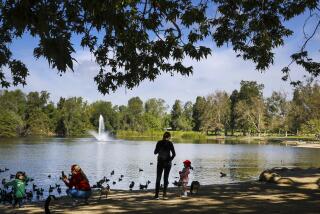Santa Monica to regulate use of public parks for fitness classes

Santa Monica will regulate the use of its public parks for fitness classes and charge fees to trainers after complaints from some residents that their space has become overrun by athletic enthusiasts.
In a 5-1 vote last week, the City Council set restrictions on which parks can be used for training, when they can be used, how many students can participate in a class and what kind of equipment is allowed. The council also established permit fees and an additional flat fee to be paid by trainers, which varies based on the size of their classes.
The moves come after some residents began complaining that too many people were training at the parks and that a handful of instructors were tearing up the public land with heavy weights and other equipment.
The debate centered largely on whether to allow classes at Palisades Park — a city landmark with an ocean view — and reached a crescendo earlier this year when city staff began drawing up regulatory guidelines. Trainers insisted they be allowed to continue using the space, while some residents said that protecting the park was paramount.
The city estimated that in a single week in October 2012, 73 group fitness classes and 74 private classes were held in Palisades Park.
At the council meeting, members were split about whether to allow training at the park, and eventually reached a compromise that would prohibit training there on Sundays. Trainers will also have to pay an annual fee in the thousands of dollars to run their classes — and will be charged 50% more if they wish to operate in Palisades Park.
City officials said they expect to begin the application process for permits in December and would begin collecting fees by January. The regulatory system was adopted as a one-year pilot program, after which officials plan to provide the council with an evaluation.
More to Read
Start your day right
Sign up for Essential California for news, features and recommendations from the L.A. Times and beyond in your inbox six days a week.
You may occasionally receive promotional content from the Los Angeles Times.







